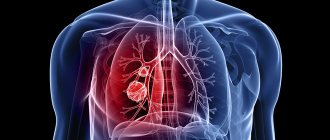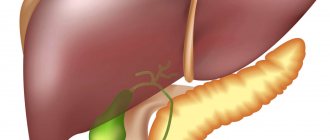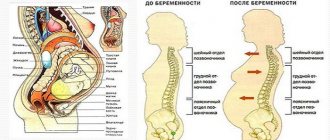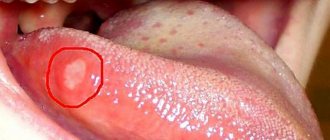Signs and symptoms
Mallory-Weiss syndrome is most often characterized by abdominal pain, a history of severe vomiting, vomiting blood (hematesis), and a strong involuntary effort to vomit. The blood is often clotted and has a “coffee grounds” appearance. The stool may be dark as tar (melenik). In cases where significant blood loss occurs, shock and collapse are possible.
People with Mallory-Weiss syndrome may also experience severe, painless internal gastrointestinal bleeding (hemorrhage) due to tears in the mucous membranes. However, in most cases (80-90%) such bleeding stops spontaneously. In very rare cases, bleeding can become life-threatening.
Classification of pathology
Mallory-Weiss syndrome has a classification based on the severity of ruptures in the esophageal wall, which can be determined using fibrogastroscopy:
- Stage I – there are small cracks in the mucous membrane of the esophagus, mainly in its lower third, near the transition to the stomach. The bleeding is insignificant (most often F3).
- Stage II - there is a rupture of not only the mucous membrane, but also the submucosal layer of the esophagus (F1b or F1c).
- Stage III - rupture of the esophageal muscles (F1a, F1c and F1d) occurs.
- Stage IV - rupture of all walls of the esophagus (perforation), leading to the development of severe complications - peritonitis, mediastenitis, hemothorax (F1a and F1d).
The classification of Mallory-Weiss syndrome according to the severity of bleeding (established after fibrogastroscopy), which is also applicable for other gastrointestinal bleeding, is also of important diagnostic importance:
- Bleeding F1 – indicates that bleeding is still ongoing. In turn, it is divided into the following subgroups:
- F1a – severe bleeding from a ruptured wall of the esophageal artery.
- F1b – diffuse, capillary bleeding, usually not very strong, which is noted at the edge of the crack in the mucous membrane.
- F1c – there are blood clots at the site of the ruptures (the bleeding has almost stopped), but there is slight bleeding at the edges of the clot.
- F1d – bleeding is so severe that it is impossible to determine its location. It is observed with severe arterial and multiple diffuse capillary bleeding.
- F2a – endoscopy reveals a thrombus in a mucosal rupture.
- F2b - at this stage, a blood clot is detected in a fissure in the mucous membrane of the esophagus, but there is no bleeding.
- F2c – this stage is characterized by the inclusion of hemosiderin (blood that has come into contact with stomach acid) in the ruptures of the mucosa.
Mallory-Weiss syndrome is extremely rare in children. When it occurs, the main development factors are acute poisoning, congenital anomalies of intestinal development, and acquired hernias.
Causes and risk factors
In most cases, the immediate cause of Mallory-Weiss syndrome is severe vomiting. It may be associated with chronic alcoholism, but SMS can also be the result of severe trauma to the chest or abdomen, chronic hiccups, intense snoring, lifting and straining, inflammation of the lining of the stomach (gastritis) or esophagus (esophagitis), diaphragmatic hernia or CPR (cardiovascular). pulmonary resuscitation). Cancer patients undergoing chemotherapy may develop this disorder as a complication of chemotherapy.
Authorized Products
The diet for Mallory-Weiss syndrome includes:
- Soups prepared with potato/vegetable broth, to which carefully pureed cereals (semolina, buckwheat, rolled oats, rice) and vegetables are added, and then switched to non- pureed ones. It is allowed to add an egg-milk mixture, pureed meat, and a little butter.
- Lean dietary meat (chicken/turkey, rabbit, beef, veal) from which steamed/boiled dishes are prepared (bits, cutlets, soufflé, zrazy, quenelles). A month after the operation, you are allowed to eat meat baked in the oven.
- Porridges cooked in milk/water from buckwheat and oatmeal, rice, you can eat small vermicelli. Porridges should be well boiled and pureed. Puddings/casseroles are prepared from cereals with the addition of cottage cheese.
- Low-fat varieties of fish without skin, steamed/baked without crust in pieces/chopped (zrazy, cutlets, meatballs, meatballs).
- Vegetables containing a small amount of fiber (pumpkin, zucchini, potatoes, green peas, cauliflower, beets, carrots) are steamed and served pureed. To improve the taste, you can add chopped dill.
- Stale/dried wheat bread, dry biscuits.
- Small amounts of butter/vegetable oil as a dressing for ready-made dishes.
- Chicken eggs, which are prepared as a steamed omelette/soft-boiled.
- Milk and cream, curdled milk and kefir, fresh non-sour cottage cheese or lazy dumplings, cheesecakes, puddings. Rarely - mild cheese.
- Desserts from mashed berries, steamed (mashed potatoes, sambuca, jelly, jelly) compotes. Sweet fruits/berries can be consumed baked. It is allowed to eat meringues, marshmallows, honey, non-sour jam, and marshmallows.
- Drinks include rosehip infusion, fruit juices, weak coffee/tea with milk/cream.
Disorders with similar symptoms
Symptoms of the following disorders may be similar to those of Mallory-Weiss syndrome. Comparisons can be useful for differential diagnosis:
- Zollinger-Ellison syndrome is a rare disease characterized by small tumors (usually in the pancreas) that secrete a hormone that produces excess stomach acids, which cause ulcers. These tumors may also appear in the lower wall of the stomach, spleen, or lymph nodes near the stomach. Large amounts of stomach acid can be found in the lower sections of the stomach, where many ulcers form. Ulcers may appear suddenly even in areas where they are rare, may persist after treatment, and may be accompanied by diarrhea. To prevent complications such as bleeding and perforation, surgical treatment of these ulcers is necessary.
- Chronic erosive gastritis is a common inflammation of the stomach, characterized by multiple lesions of the mucous membrane, causing ulcer-like symptoms. These symptoms may include a burning sensation in the pit of the stomach, mild nausea, vomiting, loss of appetite and weakness. In severe cases, there may be stomach bleeding, which can lead to anemia. Some people with this disorder, especially those who regularly use aspirin, may not experience symptoms until the disease progresses. An accurate diagnosis can be made by a doctor by visually examining the stomach using a gastroscope.
- Boerhaave's syndrome is a very serious disease characterized by rupture of the esophagus. Rupture usually occurs from severe vomiting after eating too much. People with this disorder may have severe abdominal and chest pain, shortness of breath, a fast heartbeat (tachycardia), a bluish discoloration of the skin (cyanosis), and eventually poor circulation due to blood loss (shock) through the esophagus. Surgery is usually required to repair this type of tear. It is important that this disorder is diagnosed promptly so that treatment can be initiated as soon as possible.
- Esophageal perforation is a tear in the esophagus. When a rupture occurs in the throat area, there may be swelling in the neck and constant pain that extends from the chest to the back. If it occurs in the chest, there may be vomiting, upper abdominal pain, shortness of breath, and severe chest pain. This disorder may be caused by chemical burns to the throat, complications due to inflammation of the esophagus (esophagitis), stomach ulcers, or abnormal growth (neoplastic growth). Diagnostic medical procedures such as endoscopy or gastroscopy can also cause esophageal perforation.
- Peptic ulcer is a very common disease characterized by damage to the mucous membranes of the esophagus, stomach or duodenum. Peptic ulcers are caused by excessive secretion of acid or pepsin and are characterized by pain, heartburn, nausea and vomiting.
- Esophageal varices are dilated, enlarged, and tortuous veins, arteries, or lymphatic vessels at the lower end of the esophagus as a result of portal hypertension; they are superficial and prone to ulceration and massive bleeding.
Diagnostics
Doctors suspect the diagnosis of Mallory-Weiss syndrome in people who have blood in their vomit after one or more episodes of vomiting. If the bleeding is light, doctors may wait to do testing because the bleeding may stop on its own.
If bleeding is severe or does not stop on its own, doctors do an upper endoscopy. During an upper endoscopy, doctors examine the esophagus using a flexible tube called an endoscope. Upper gastrointestinal endoscopy allows doctors to see the cause of bleeding and often treat it at the same time.
If the bleeding is rapid or severe, doctors sometimes perform an angiogram. During an angiography, doctors use a catheter to inject a fluid (contrast agent) into the artery, which is visible on x-rays.
Emergency care for Mallory-Weiss syndrome
The correctness of actions determines how quickly a person will recover after bleeding. First aid must be provided professionally and without delay.
If gastroesophageal rupture-hemorrhagic syndrome occurs, the following must be done before doctors arrive:
- Provide the patient with complete rest. Any action will only increase the bleeding.
- Apply ice to your stomach. Cold causes blood vessels to spasm, which stops bleeding.
- If there is a urge to vomit, the patient is given drugs with an antiemetic effect, for example, Cerucal or Metoclopramide.
Standard Treatments
In many cases, bleeding caused by Mallory-Weiss syndrome will stop without treatment. In cases where bleeding continues, treatment may involve sealing the lesion by applying heat or chemicals (cauterization) or high-frequency electrical current (electrocautery).
Blood transfusions and/or the use of the vasopressive drug Pitressin may be required. Among other actions, the hormone Pitressin acts on the muscles of the capillaries, affecting blood pressure. Direct pressure can also be used by inserting a catheter surrounded by a balloon. The balloon is then inflated (balloon tamponade) to stop the bleeding.
Mallory-Weiss syndrome - treatment
Therapy must simultaneously perform the following tasks:
- Stop the bleeding.
- Eliminate hemodynamic disturbance.
- Normalize the patient's general condition.
Self-medication is unacceptable! A qualified doctor must provide assistance to the patient: without it, the person will simply die.
Mallory syndrome involves the following treatment:
- To stop bleeding and restore circulating volume, a 0.9% saline solution or 5% glucose is prescribed.
- To block the production of hydrochloric acid, Nolpaza, Omeprazole or Rabeprazole are prescribed.
- Gastal and Rennie help neutralize the effects of hydrochloric acid.
- Antacids are prescribed to coat the walls of the digestive tract. The most common are Venter, De-nol and Gaviscon.
If Mallory-Weiss syndrome occurs due to cough or is provoked by other similar factors, endoscopy is used.
There are several options for performing this operation:
- injecting the bleeding area with adrenaline;
- cauterization of blood vessels with argon;
- electrocoagulation;
- cryotherapy on sources of bleeding;
- stopping bleeding by administering a sclerosing agent;
- clipping of blood vessels.
If drug and endoscopic therapy does not provide the desired result, surgery is performed. During this procedure, the surgeon stitches up the bleeding vessels and the broken mucous membrane. For deep ruptures, surgery is the only way to save the patient's life. The recovery period is also considered equally important. At this stage, it is important for the patient to follow the doctor's instructions exactly.
Mallory-Weiss syndrome - clinical guidelines
Since people who abuse alcohol are in the risk category, alcohol should be avoided to prevent relapse. Mallory-Weiss syndrome also has clinical recommendations regarding nutrition. In the future, it is important for the patient to reconsider his diet. However, attention should be paid not only to its components, but also to their quantity. Overeating is unacceptable! If Mallory-Weiss syndrome is diagnosed in pregnant women, the woman should be under medical supervision until delivery. This will help him monitor the situation and provide timely assistance.
Mallory-Weiss syndrome - diet
A properly developed nutritional system will help alleviate the patient’s condition and prevent relapse. For this reason, it is important to understand what you can eat if Mallory-Weiss syndrome is diagnosed. In the first day after bleeding occurs, fasting is recommended. Subsequently, all food consumed must be thoroughly processed. Products must be processed thermally and mechanically. Experts recommend giving preference to broths and porridges, as well as pureed dishes.
At the same time, the temperature of the food consumed should be comfortable: hot or too cold food is unacceptable. When Mallory-Weiss syndrome is diagnosed, meals should be divided: 5-6 times a day. Salty, fried or fatty foods, and alcoholic drinks should be excluded from the diet.
The menu should include the following products:
- steamed vegetables;
- boiled lean meat;
- porridge with milk or water;
- steamed lean fish;
- milk, kefir, yogurt;
- steamed desserts;
- rosehip infusion.
Forecast
The prognosis for Mallory-Weiss syndrome (MWS) is generally good. Bleeding from the lesions stops spontaneously in 80-90% of patients. With conservative therapy, most ruptures heal without complications within 48-72 hours. Thus, SMV may be easily missed if endoscopy is delayed.
The amount of blood loss varies. Earlier studies reported that the proportion of patients requiring blood transfusion was 40-70%. Currently, these numbers are likely significantly lower.
Hemodynamic instability and shock may occur in 10% of patients with Mallory-Weiss syndrome. In one series, the mortality rate reached 8.6%; However, current clinical experience suggests a significantly lower mortality rate from SMV.
In one prospective 5-year study (2005–2009), Ljubicic et al found that mortality rates in high-risk patients with Mallory-Weiss syndrome were similar to those in patients with ulcer bleeding. The researchers sequentially evaluated data from 281 patients with endoscopically confirmed Mallory-Weiss syndrome and 1,530 patients with ulcer bleeding. Significant prognostic factors for both conditions included age over 65 years and the presence of significant comorbidities.












